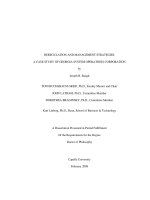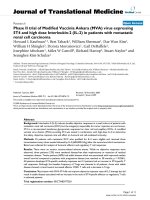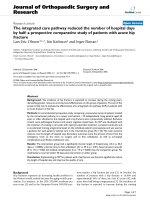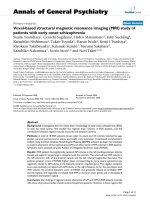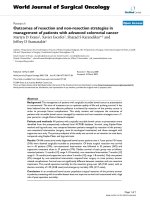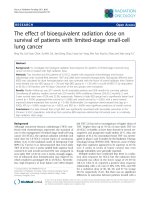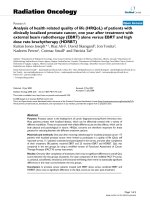Dose escalating study of cetuximab and 5-FU/ folinic acid (FA)/oxaliplatin/irinotecan (FOLFOXIRI) in first line therapy of patients with metastatic colorectal cancer
Bạn đang xem bản rút gọn của tài liệu. Xem và tải ngay bản đầy đủ của tài liệu tại đây (466.14 KB, 8 trang )
Folprecht et al. BMC Cancer 2014, 14:521
/>
RESEARCH ARTICLE
Open Access
Dose escalating study of cetuximab and 5-FU/
folinic acid (FA)/oxaliplatin/irinotecan (FOLFOXIRI)
in first line therapy of patients with metastatic
colorectal cancer
Gunnar Folprecht1*, Susanne Hamann1,2, Katharina Schütte1,3, Tanja Trarbach4,5, Jan Stoehlmacher-Williams1,6
and Gerhard Ehninger1
Abstract
Background: The FOLFOXIRI regimen (irinotecan, oxaliplatin, fluorouracil [5-FU] and folinic acid [FA]) increased the
response rate and overall survival compared to FOLFIRI in patients with metastatic colorectal cancer (mCRC).
Adding cetuximab to FOLFOX or FOLFIRI increased efficacy in patients with k-ras wild type mCRC. We explored the
dose limiting toxicity and feasibility of the combination cetuximab, irinotecan, oxaliplatin, 5-FU and FA in mCRC
patients.
Methods: In a dose-escalation study patients with previously untreated mCRC and a WHO performance status 0–1
received cetuximab (500 mg/m2, 2 h), followed by irinotecan (95, 125, and 165 mg/m2 in the dose levels [DL] 1, 2,
and 3 respectively), followed by oxaliplatin (85 mg/m2, 2 h) which was given parallel to FA (400 mg/m2, 2 h) and
followed by 5-FU (3200 mg/m2, 46 h) in an outpatient setting every two weeks. The primary endpoints were the
maximum tolerable dose and the safety. The trial was approved by the local ethics committee.
Results: From 2007 to 2008, twenty patients were treated in this trial. In the first dose level (irinotecan 95 mg/m2)
one patient developed neutropenia grade 4. One patient experienced diarrhoea grade 3 as DLT in dose level 2
(irinotecan 125 mg/m2). In dose level 3 (irinotecan 165 mg/m2), three patients experienced a DLT (diarrhoea grade
3 and two patients with neutropenia grade 4). Thus, the recommended dose for a phase II trial is 125 mg/m2
irinotecan in combination with oxaliplatin, 5-FU/FA and cetuximab. Most common grade ≥3 toxicities were
neutropenia (40%), diarrhoea (25%) and acne-like rash (15%). No therapy associated death occurred.
The confirmed overall response rate in all cohorts was 75% (95%-CI 51-91%). The best response was reached after a
median of 3.0 (95%-CI 2.2 to 3.7) months. Median progression free survival (PFS) is 16 (95%-CI 12.6-19.4) months,
overall survival (OS) 33 (95%-CI 26.2-39.8) months.
Conclusions: The combination of cetuximab and FOLFOXIRIis feasible and has an acceptable toxicity profile in
patients with a good performance status. The observed clinical activity with a confirmed response rate of 75% is
promising and further evaluated in the ongoing CELIM2.
Trial registration: www.clinicaltrials.gov: NCT00422773.
Keywords: Cetuximab, Phase I, Metastatic colorectal cancer, Irinotecan, Oxaliplatin, 5-FU, Chemotherapy
* Correspondence:
1
Medical Department I, University Hospital Carl Gustav Carus, University
Cancer Center, Fetscherstr 74, 01307 Dresden, Germany
Full list of author information is available at the end of the article
© 2014 Folprecht et al.; licensee BioMed Central Ltd. This is an Open Access article distributed under the terms of the Creative
Commons Attribution License ( which permits unrestricted use, distribution, and
reproduction in any medium, provided the original work is properly credited.
Folprecht et al. BMC Cancer 2014, 14:521
/>
Background
Colorectal cancer (CRC) is a leading cause of cancer related death in Europe. Despite advances in the systemic
treatment of metastatic colorectal cancer (mCRC), the
long term prognosis of patients with (mCRC) still remains unfavourable unless a resection can be performed.
Metastasectomies can provide curative treatment with a
5-year overall survival of 48% if (liver) metastases are resectable at the time of diagnosis of the metastases and
33%, if initially non-resectable liver metastases are
resected after tumour shrinkage due to chemotherapy
[1]. Therefore, a major treatment goal of initially unresectable mCRC is to intensify chemotherapy to increase
the number of secondarily resectable patients. As there
is a correlation between response to chemotherapy and
the resection rate [2] it might be interesting to develop
chemotherapy schedules that are able to induce early
and meaningful tumour shrinkage.
Both irinotecan and oxaliplatin, each in combination with
infusional 5-fluorouracil (5-FU)/ folinic acid (FA) have been
the standard chemotherapy regimens in mCRC inducing
response rates (RR) of 40% to 50% [3,4]. One strategy to
maximize tumour response is to combine all cytotoxic
drugs into a “FOLFOXIRI” regimen. Such an approach
had promising results in earlier phase II trials [5]. An
Italian phase III trial demonstrated an increase of the
RR and a prolongation of the progression free and overall
survival with significantly more liver resections in the FOLFOXIRI arm, but also increased toxicity, especially diarrhoea and neutropenia compared to the FOLFIRI arm [6].
Cetuximab improved efficacy when combined with oxaliplatin/5-FU/FA [7] or with irinotecan/5-FU/FA if activating
k-ras mutations were absent. With cetuximab plus FOLFIRI, the rate of liver resections was increased compared to
FOLFIRI alone [8]. Although the typical toxicities of cetuximab monotherapy are mostly limited skin and allergic reactions [9], diarrhoea and other toxicities were increased if
cetuximab was combined with chemotherapy [7,10].
The current study was carried out to determine a dose
of the combination of cetuximab, irinotecan, oxaliplatin
and 5-FU/FA for further evaluation in neoadjuvant treatment of patients with colorectal liver metastases in
future trials.
Page 2 of 8
FU/folinic acid as first-line treatment for metastatic colorectal cancer. Secondary objectives were feasibility, toxicity,
response rate, resection rate, progression free and overall
survival.
Three or six patients were planned to receive chemotherapy at each dose level starting with the lowest doselevel. The dose was escalated by one dose level if none
of the first three patients or less than two of six patients
at a particular dose level experienced a dose-limiting
toxicity (DLT) during the first six weeks.
Up to four dose levels and a MTD cohort of 16 patients to explore the irinotecan dosing schedule in the
combination of FOLFOXIRI/cetuximab were originally
planned. However, this extended phase was not effected
as the recruitment was stopped when the influence of
the k-ras mutational status in first line therapy was
demonstrated [8].
Patient selection
Patients with histologically confirmed non-resectable
colorectal cancer, without prior treatment for metastatic
disease and with a WHO performance status (PS) 0–1
were eligible for this trial. They were enrolled 2007/2008
and were not selected for epidermal growth factor receptor (EGFR) immunohistochemistry or k-ras status.
Exclusion criteria were prior anti- EGFR therapy, prior
radiotherapy or major abdominal or thoracic surgery
within the last 4 weeks before inclusion, known hypersensitivity reaction to any of the components of the
study treatment, clinically relevant coronary disease or
myocardial infarction within 12 months before study
entry, peripheral neuropathy Common Terminology Criteria for Adverse Events (CTCAE) > grade I, acute or
sub-acute intestinal obstruction or inflammatory bowel
disease, previous malignancy (except CRC, history of
basal cell carcinoma of skin or pre-invasive carcinoma of
the cervix with adequate treatment), brain metastasis,
adjuvant treatment within 6 months before study, inadequate renal, hepatic or hematologic function, history of
severe psychiatric illness, concurrent anti-cancer treatment, age <18 years and pregnant or lactating women.
Treatment and evaluation
Methods
Study design
This open-label, non-randomized, dose-escalation trial
was planned to determine the MTD for FOLFOXIRI and
Cetuximab in the first line treatment of patients with
metastatic colorectal cancer. It was conducted in two
German University Cancer Centres.
The primary objective was to assess a maximum tolerable dose and the safety of the chemotherapy-antibodycombination of cetuximab, irinotecan, oxaliplatin and 5-
Patients received biweekly i.v. doses of cetuximab
(500 mg/m2, 2 h), followed by irinotecan (95, 125, and
165 mg/m2 in the dose levels [DL] 1, 2, and 3),
followed by oxaliplatin (85 mg/m2, 2 h) which was
given parallel (via separate line) to FA (400 mg/m2, 2 h)
and followed by 5-FU (3200 mg/m2, 46 h) in an outpatient
setting. Twelve cycles were planned.
Adverse events (AE) were rated according to the National Cancer Institute-Common Toxicity Criteria (NCTCTC, version 3.0).
Folprecht et al. BMC Cancer 2014, 14:521
/>
DLTs were defined as: neutropenia grade 4 or febrile
neutropenia, thrombocytopenia grade 3, diarrhoea
grade 3 lasting > 24 h if adequately treated with loperamide or diarrhoea grade 3 in combination with
neutropenia grade ≥ 3, nausea/ vomiting grade 3 despite
anti-emetic treatment, acne-like rash grade 4 and other
non–haematological grade 3 toxicity (except alopecia).
Hematopoietic growth factors were allowed after neutropenia grade 3.
Imaging for the assessment of tumour response was
carried out at baseline (within three weeks before treatment start) and repeated after every third cycle (6 weeks).
Responses were assessed and confirmed according to
RECIST1.0 [11]. A waterfall plot was calculated by the
percentage of tumour reduction between baseline and
time of best response for measurable target lesions.
Progression free survival and overall survival were
calculated by the method of Kaplan-Meier. Patients who
started a subsequent therapy line without formal progression were censored for the calculation of progression
free survival.
K-ras was retrospectively analysed for mutations in
codon 12/13 after macrodissection by pyrosequencing
using the commercial therascreen kit (Qiagen). The dose
intensity per cycle was calculated as the relationship of
delivered by the planned doses from treatment start
multiplied by the ratio of planned vs actual treatment
days.
Ethical considerations and funding
All patients gave written informed consent. The trial
was conducted according to the Declaration of Helsinki
with amendments and the Guidelines for Good Clinical
Practice ICH Tripartite Guideline. It was approved by
the local ethics committee and the national and federal
health authorities.
The legal sponsor of this trial was the Technical
University of Dresden which had the full control of the
data base.
The study was funded by educational grants from
Merck Pharma Deutschland GmbH and Pfizer Pharma
Deutschland GmbH.
Results
Patients
Twenty-one patients were enrolled into the study
between January 2007 and June 2008. One patient registered for DL2 was excluded from further treatment and
all analyses because of leakage of his i.v. port-catheter
system before the first full dose of chemotherapy was
completed (Figure 1).
All analyses refer to the remaining 20 patients who actually received at least one full cycle of study treatment.
Median age was 59 (34–72) years. Fifteen patients
Page 3 of 8
presented with a WHO PS 0 (75%), fifteen were male
(75%). Ten patients had rectal cancer (50%). Seven patients had liver (6 pts) or lung (1 patient) metastases,
only. Thirteen patients had extrahepatic, non-lung
metastases. Further patient characteristics are shown in
Table 1.
Treatment, DLT and determination of MTD
Dose escalation
A minimum of three enrolled patients per dose level was
planned. One patient in dose level 1 (DL1, irinotecan
95 mg/m2) developed neutropenia grade 4, five further
patients in DL1 had no DLTs. In the second dose level
(irinotecan 125 mg/m2), one patient experienced diarrhoea grade 3 that was regarded as DLT. Five additional
patients in DL 2 had no DLTs. Two patients had to be
replaced in the first two dose levels, one patient with
traumatic pelvic fracture (DL1), and one patient with a
late postoperative complication of adhesive ileus (DL2).
In dose level 3 (irinotecan 165 mg/m2), three patients
experienced a DLT (one patient with diarrhoea grade 3
and two patients with neutropenia grade 4). Therefore,
further dose escalation was terminated and 125 mg/m2
irinotecan in combination with oxaliplatin, 5-FU/FA and
cetuximab was recommended as the dose for further
evaluation.
Toxicity
Twenty patients were evaluable for toxicity. No therapy
associated death was observed. The most common grade
≥3 toxicities were neutropenia (40%), diarrhoea (25%)
and acne-like rash (15%). An overview of the toxicities is
shown in Table 2.
Treatment duration
The median number of cycles received was 7.5 for DL1,
9.7 for DL2 and 12 for DL3. Two patients received only
one cycle of treatment, one patient owing to a late postoperative ileus (DL 2) and one patient due to a traumatic
pelvic fracture (DL 1). Eight out of the 20 patients completed 12 cycles (one patient in DL1 and DL2, respectively, and all six patients in DL3). Two patients stopped
study therapy for surgery (after 8 and 10 cycles, DL 1
and 2 respectively). Treatment was discontinued due to:
unacceptable toxicity in three patients (one patient with
diabetic foot ulcer, one patient with skin toxicity (paronychia and polyneuropathy), and one patient with perforation of the transverse colon, all in DL2); withdrawal
of consent in three patients (after 6, 8 and 11 cycles
respectively, all DL1); complete response of all lesions in
one patient, (after 7 cycles, DL1) and a adminstrative
mistake in one patient (after 11 cycles, DL2).
Folprecht et al. BMC Cancer 2014, 14:521
/>
Page 4 of 8
21 patients enrolled
1 pat with port dysfunction on day 1
20 patients received ≥1 full
cycle
1 pat with traumatic pelvic fracture (DL1)
1 pat with late postoperative complication (DL2)
(adhesive ileus)
18 patients evaluable for DLT
DL1
DL2
DL3
6 patients
6 patients
6 patients
1 DLT
1 DLT
3 DLTs
Figure 1 Contribution of patients on the separate dose levels.
Table 1 Patients characteristics
Characteristics
DL1
DL2*
DL3
n
n
n
20 (100)
7
7
6
Male
15 (75)
4
6
5
Female
5 (25)
3
1
1
59 (34–72 )
57 (34–72)
64 (43–67)
57 (44–69)
15 (75)
5
7
3
Colon
10 (50)
4
5
1
Rectum
10 (50)
3
2
5
None
17 (85)
4
7
6
5-FU (infusional)
3 (15)
3
0
0
5-FU (bolus)
1 (5)
1
0
0
Oxaliplatin
2 (10)
2
0
0
1.75 (1–3)
2.1 (1–3)
1.7 (1–3)
1.3 (1–2)
Wild type
14 (70)
6
3
5
Mutant
6 (30)
1
4
1
Total patient number
n (%)
Gender
Age
Median Age – years (range)
ECOG PS
ECOG PS 0
Primary tumor site
Previous adjuvant therapy
Number of metastatic sites
Median number (range)
KRAS status (retrospective)
*One further patient in this dose level was excluded from all analyses owing to i.v. port-catheter dysfunction during the first dose.
Folprecht et al. BMC Cancer 2014, 14:521
/>
Page 5 of 8
Table 2 Toxicity
Toxicity
Grade
All DL n (%)
DL1 (n)
DL2 (n)
n = 20
n =7
n =7
DL3 (n)
n =6
All
Gr. 3
Gr. 4
All
Gr. 3/4
All
Gr. 3/4
All
Gr. 3/4
14 (70)
3 (15)
5 (25)
5
2
3
2
6
4
Thrombopenia
11 (55)
1 ( 5)
0 (0)
4
1
4
0
3
0
Anaemia
10 (50)
0 (0)
0 (0)
3
0
4
0
3
0
Diarrhoea
15 (75)
5 (25)
0 (0)
6
1
4
2*
5
2*
Nausea
13 (65)
0 (0)
0 (0)
7
0
4
0
2
0
Vomiting
6 (30)
1 (5)
0 (0)
5
1
1
0
0
0
Stomatitis
14 (70)
0 (0)
0/ 0
6
0
3
0
5
0
Other Mucositis
5 (25)
0 (0)
0 (0)
1
0
1
0
3
0
Bowel Obstruction
1 (5)
0 (0)
1 (5)
0
0
0
1
0
0
Hematologic
Neutropenia
Gastrointestinal
General disorders
Fatigue
16 (80)
0 (0)
0 (0)
5
0
5
0
6
0
Skin toxicity
18 (90)
3 (15)
0 (0)
6
1
6
2
6
0
Paronychia
6 (30)
1 (5)
0 (0)
0
0
2
0
4
1
*One patient fulfilling DLT criteria.
Dose intensity
The dose intensity for the first six cycles was 94%, 89%,
88% and 89% for cetuximab, irinotecan, oxaliplatin and
5-FU. The dose intensity from treatment start over the
time is shown in Figure 2.
Efficacy
Tumour response
In all treated patients, the overall confirmed response
rate was 75% (15/20 patients, 95% CI 51-91%). Fourteen
Figure 2 Dose intensity from treatment start according to the cycle.
patients (70%, 95% CI 48-86%) had a partial response
(PR) and one patient (5%) had a complete response
(CR). Three patients (15%, 95% CI 4-37%) had stable
disease (SD). There was no patient with progressive
disease as best response; the two replaced patients
(with traumatic pelvic fracture and with mechanical bowel
obstruction) were not evaluable for response. Best
response was reached after a median of 3.1 months. The
responses according to cohorts and the waterfall plot are
shown in Table 3 and Figure 3.
Folprecht et al. BMC Cancer 2014, 14:521
/>
Page 6 of 8
5-FU 3 pts, FOLFIRI-like schedules 6 pts, cetuximab/
FOLFOX – 2 pts, cetuximab/FOLFIRI – 1 patient).
The median OS did not differ between patients with
metastases confined to liver and lung (33.0 months, 95%
CI 25.6 – 39.4 months) and patients with other metastases (34.1 months, 95% CI 23.9 – 44.3 months, p = 0.6).
The median progression free survival was 21.4 months
[95% CI: 10.3 – 32.5] and 14.5 months [95% CI: 10.76 –
18.2, p = 0.99] in patients with liver/lung metastases and
patients with extrahepatic, non-lung metastases.
Table 3 Response to treatment
Total (n)
DL1 (n)
DL2 (n)
DL3 (n)
n = 20
n =7
n =7
n =6
Complete Remission
1
1
0
0
Partial Remission
14
2
6
6
Response
Stable Disease
3
3
0
0
Not evaluable
2
1
1
0
In three out of twenty patients study treatment was
followed by metastasectomy after 8, 10 and 12 cycles.
K-ras mutational status was determined in all 20 patients.
In 14 patients with k-ras wild type tumours, one patient
had complete response and nine PR (response rate 72%
[95% CI 42-92%]), three patients stable disease, one was not
evaluable. Out of six k-ras mutant patients, five were evaluable for response. All five patients had a partial response.
Six out of seven patients with metastases limited to
the liver or lung responded to treatment (86%)
compared to 9/13 patients with extrahepatic, non-lung
metastases (69%).
Discussion
Adding oxaliplatin or cetuximab to FOLFIRI resulted in
higher RR, longer OS and higher rates of liver resection
[6,8]. To combine both approaches might be an effective
way to intensify treatment in selected patients with good
performance status and k-ras wild type tumours. However,
both combinations were associated with increased toxicity
compared to FOLFIRI alone. To prepare further trials, the
aim of this phase I trial was to determine the MTD of the
chemotherapy combination of cetuximab, irinotecan,
oxaliplatin and 5-FU/FA for future studies in patients
with non-resectable liver metastases.
In our study, we have shown that it is feasible to administer cetuximab in combination with oxaliplatin, 5-FU/FA
and irinotecan. However, diarrhoea and neutropenia limited
the maximum dose of irinotecan which is recommended
for further trials to 125 mg/m2, lower than in the FOLFOXIRI schedule (165 mg/m2) without cetuximab [6].
Our findings of increased toxicity are in line with the
POCHER trial investigating the same drugs in a chronomodulated schedule requiring a dose reduction during
the trial [12]. A French trial investigating cetuximab
Progression free and overall survival
Twenty patients were evaluable for survival analysis. At
the time of analysis, eight patients (40%) were alive, seven
with disease progression and one without progression.
Median progression free survival (PFS) was 16.0 (95%CI 12.6-19.4) months, overall survival (OS) was 33.0
(95%-CI 26.2-39.8) months (Figure 4). Eighteen patients
(90%) received second line treatment which was heterogeneous, consisting mostly of antibody or doublet combinations (bevacizumab/FOLFIRI - 6 pts, bevacizumab/
*
*
* m * m *
*
*
* m * m m *
*
*
*
0
-20
-40
CR
PR
-60
SD
-80
-100
Figure 3 Best response of target lesions by patient, regardless of k-ras status (evaluable patients). CR – complete response, PR – partial
response, SD – stable disease, m - k-ras mutant, * - k-ras wildtype Two patients (one patient with k-ras wt and one patient with k-ras mutant
tumour) were not evaluable for response as they were excluded from the study after cycle one without response evaluation. One patient with
stable disease had no change in tumor size.
Folprecht et al. BMC Cancer 2014, 14:521
/>
Page 7 of 8
1
OS
OS, censored
0.8
PFS
PFS, censored
0.6
0.4
0.2
0
0
6
12
18
24
30
36
42
48
54
60
Figure 4 Overall survival (OS) and Progression free survival (PFS).
and FOLFIRINOX did not reduce the chemotherapy
(180 mg/m2 irinotecan, 85 mg/m2 oxaliplatin and 5-FU/
FA) but reported a diarrhoea grade 3/4 rate of 52%, and
a neutropenia grade 3/4 rate of 38% [13].
The confirmed response rate of 75% (irrespective of
the k-ras status) is promising and - in the historical comparison - numerically higher than FOLFOXIRI (response
rate of 66% [6]) or cetuximab/FOLFIRI (confirmed response rates 57.3% in k-ras wild type and 39.7% in k-ras
mutant patients [8]). However, the low patient number
and the subsequently large confidence interval in our study
do not allow any final conclusion, especially for subgroup
analysis, i.e. regarding the unexpected finding that the
response was slightly higher in k-ras exon 2 mutant
patients or patients or the known phenomenon of
numerically higher response rates in patients with metastases in liver or lung, only.
In this trial that did not select patients with potentially
resectable metastases but included a relatively high proportion of patients with more than one metastatic site
(55%), three patients were resected for metastases and one
patient stopped chemotherapy prematurely because of an
early complete response. The overall survival belongs to
the longest reported in clinical trials for metastatic colorectal cancer that were not conducted in the setting of
neoadjuvant therapy. Patient selection, the high number
of patients with second line treatment (90%) and the
concept of an intensive induction treatment may have
contributed to the favourable outcome.
The short time until best response of 3.1 months might
be important for neoadjuvant chemotherapy in potentially
resectable metastases, as a higher number of chemotherapy cycles is associated with higher perioperative morbidity [14]. Even though the distribution of PS is comparable
to other trials investigating intensive chemotherapy
combinations [6], we do not recommend this schedule for
patients with an impaired PS, considering, that 75% of
the patients in our trial had a WHO PS 0. Our regimen
might be a treatment option for patients with potentially
resectable liver metastases, in whom the chance of a
curative resection outweighs the risk of the high toxicity of such an intensive regimen, and also in other
patients with a high need for intensive treatment [15].
The ongoing CELIM2 study is investigating this chemotherapy schedule in patients with k-ras wild-type liver
metastases (NCT01802645).
Conclusions
In conclusion, this phase I trial was able to demonstrate
that this intensive combination of cetuximab, oxaliplatin,
5-FU/FA and irinotecan in mCRC is feasible and has an
acceptable toxicity profile in patients with a good PS. In
these patients, the observed clinical activity with a
confirmed response rate of 75% is promising and might
be interesting i.e. in neoadjuvant treatment situations.
Competing interests
The study was supported by an educational grants of Merck Pharma
Deutschland GmbH and Pfizer Pharma Deutschland GmbH.
Gunnar Folprecht received research funding (Merck KGaA), honoraries for
ad-hoc advisory boards (Merck KGaA, Genentech, Sanofi-Aventis, Lilly, Bayer,
Bristol-Myers Squibb) and lecture fees (Merck KGaA, Genentech, SanofiAventis, Lilly).
Authors’ contributions
GF has designed the trial, was involved in acquiring, analysing, interpretation
of the data and manuscript writing. SH has been involved in data analysis
and manuscript writing. KS participated in protocol writing as well as data
analysis. TT, JSW and GE were involved in acquiring and interpretation of the
data. All authors read and approved the final manuscript.
Acknowledgement
We thank all patients and their relatives for participating at this trial, Olga
Schubert and Evelyn Franke for their support in data management.
Folprecht et al. BMC Cancer 2014, 14:521
/>
Author details
1
Medical Department I, University Hospital Carl Gustav Carus, University
Cancer Center, Fetscherstr 74, 01307 Dresden, Germany. 2Medical
Department IV, Klinikum Chemnitz, Chemnitz, Germany. 3Onkologische
Gemeinschaftspraxis, Arnoldstr. 18, Dresden, Germany. 4Medical Department/
Tumour research, West Germany Cancer Center, Essen, Germany. 5ioMedico,
Freiburg, Germany. 6Onkologische Praxis, Bonn, Germany.
Received: 13 May 2013 Accepted: 16 July 2014
Published: 19 July 2014
References
1. Adam R, Wicherts DA, de Haas RJ, Ciacio O, Levi F, Paule B, Ducreux M,
Azoulay D, Bismuth H, Castaing D: Patients with initially unresectable
colorectal liver metastases: is there a possibility of cure? J Clin Oncol
2009, 27:1829–1835.
2. Folprecht G, Grothey A, Alberts S, Raab HR, Köhne CH: Neoadjuvant
treatment of unresectable colorectal liver metastases: correlation between
tumour response and resection rates. Ann Oncol 2005, 16:1311–1319.
3. Saltz LB, Cox JV, Blanke C, Rosen LS, Fehrenbacher L, Moore MJ, Maroun JA,
Ackland SP, Locker PK, Pirotta N, Elfring GL, Miller LL: Irinotecan plus
fluorouracil and leucovorin for metastatic colorectal cancer. Irinotecan
Study Group. N Engl J Med 2000, 343:905–914.
4. de Gramont A, Figer A, Seymour M, Homerin M, Hmissi A, Cassidy J, Boni C,
Cortes-Funes H, Cervantes A, Freyer G, Papamichael D, Le Bail N, Louvet C,
Hendler D, de Braud F, Wilson C, Morvan F, Bonetti A: Leucovorin and
fluorouracil with or without oxaliplatin as first-line treatment in
advanced colorectal cancer. J Clin Oncol 2000, 18:2938–2947.
5. Ychou M, Viret F, Kramar A, Desseigne F, Mitry E, Guimbaud R, Delpero JR,
Rivoire M, Quenet F, Portier G, Nordlinger B: Tritherapy with fluorouracil/
leucovorin, irinotecan and oxaliplatin (FOLFIRINOX): a phase II study in
colorectal cancer patients with non-resectable liver metastases. Cancer
Chemother Pharmacol 2008, 62:195–201.
6. Falcone A, Ricci S, Brunetti I, Pfanner E, Allegrini G, Barbara C, Crino L,
Benedetti G, Evangelista W, Fanchini L, Cortesi E, Picone V, Vitello S, Chiara S,
Granetto C, Porcile G, Fioretto L, Orlandini C, Andreuccetti M, Masi G:
Phase III trial of infusional fluorouracil, leucovorin, oxaliplatin, and
irinotecan (FOLFOXIRI) compared with infusional fluorouracil, leucovorin,
and irinotecan (FOLFIRI) as first-line treatment for metastatic colorectal
cancer: the Gruppo Oncologico Nord Ovest. J Clin Oncol 2007, 25:1670–1676.
7. Bokemeyer C, Bondarenko I, Hartmann JT, de BF, Schuch G, Zubel A, Celik I,
Schlichting M, Koralewski P: Efficacy according to biomarker status of
cetuximab plus FOLFOX-4 as first-line treatment for metastatic colorectal
cancer: the OPUS study. Ann Oncol 2011, 22:1535–1546.
8. Van Cutsem E, Köhne CH, Lang I, Folprecht G, Nowacki MP, Cascinu S,
Shchepotin I, Maurel J, Cunningham D, Tejpar S, Schlichting M, Zubel A,
Celik I, Rougier P, Ciardiello F: Cetuximab plus irinotecan, fluorouracil,
and leucovorin as first-line treatment for metastatic colorectal cancer:
updated analysis of overall survival according to tumor KRAS and BRAF
mutation status. J Clin Oncol 2011, 29:2011–2019.
9. Karapetis CS, Khambata-Ford S, Jonker DJ, O’Callaghan CJ, Tu D, Tebbutt NC,
Simes RJ, Chalchal H, Shapiro JD, Robitaille S, Price TJ, Shepherd L, Au HJ,
Langer C, Moore MJ, Zalcberg JR: K-ras mutations and benefit from cetuximab
in advanced colorectal cancer. N Engl J Med 2008, 359:1757–1765.
10. Pirker R, Pereira JR, Szczesna A, Von PJ, Krzakowski M, Ramlau R,
Vynnychenko I, Park K, Yu CT, Ganul V, Roh JK, Bajetta E, O’Byrne K, de MF,
Eberhardt W, Goddemeier T, Emig M, Gatzemeier U: Cetuximab plus
chemotherapy in patients with advanced non-small-cell lung cancer (FLEX):
an open-label randomised phase III trial. Lancet 2009, 373:1525–1531.
11. Therasse P, Arbuck SG, Eisenhauer EA, Wanders J, Kaplan RS, Rubinstein L,
Verweij J, van Glabbeke M, Van Oosterom AT, Christian MC, Gwyther SG:
New guidelines to evaluate the response to treatment in solid tumors.
European Organization for Research and Treatment of Cancer, National
Cancer Institute of the United States, National Cancer Institute of
Canada. J Natl Cancer Inst 2000, 92:205–216.
12. Garufi C, Torsello A, Tumolo S, Ettorre GM, Zeuli M, Campanella C,
Vennarecci G, Mottolese M, Sperduti I, Cognetti F: Cetuximab plus
chronomodulated irinotecan, 5-fluorouracil, leucovorin and oxaliplatin as
neoadjuvant chemotherapy in colorectal liver metastases: POCHER trial.
Br J Cancer 2010, 103:1542–1547.
Page 8 of 8
13. Assenat E, Desseigne F, Thezenas S, Viret F, Mineur L, Kramar A, Samalin E,
Portales F, Bibeau F, Crapez-Lopez E, Bleuse JP, Ychou M: Cetuximab plus
FOLFIRINOX (ERBIRINOX) as first-line treatment for unresectable metastatic
colorectal cancer: a phase II trial. Oncologist 2011, 16:1557–1564.
14. Karoui M, Penna C, Amin-Hashem M, Mitry E, Benoist S, Franc B, Rougier P,
Nordlinger B: Influence of preoperative chemotherapy on the risk of
major hepatectomy for colorectal liver metastases. Ann Surg 2006, 243:1–7.
15. Schmoll HJ, Van CE, Stein A, Valentini V, Glimelius B, Haustermans K,
Nordlinger B, van de Velde CJ, Balmana J, Regula J, Nagtegaal ID, Beets-Tan
RG, Arnold D, Ciardiello F, Hoff P, Kerr D, Kohne CH, Labianca R, Price T,
Scheithauer W, Sobrero A, Tabernero J, Aderka D, Barroso S, Bodoky G,
Douillard JY, El GH, Gallardo J, Garin A, Glynne-Jones R: ESMO Consensus
Guidelines for management of patients with colon and rectal cancer.
A personalized approach to clinical decision making. Ann Oncol 2012,
23:2479–2516.
doi:10.1186/1471-2407-14-521
Cite this article as: Folprecht et al.: Dose escalating study of cetuximab
and 5-FU/folinic acid (FA)/oxaliplatin/irinotecan (FOLFOXIRI) in first line
therapy of patients with metastatic colorectal cancer. BMC Cancer
2014 14:521.
Submit your next manuscript to BioMed Central
and take full advantage of:
• Convenient online submission
• Thorough peer review
• No space constraints or color figure charges
• Immediate publication on acceptance
• Inclusion in PubMed, CAS, Scopus and Google Scholar
• Research which is freely available for redistribution
Submit your manuscript at
www.biomedcentral.com/submit



